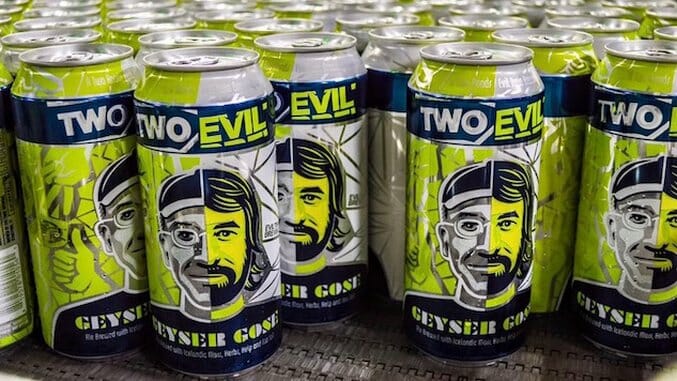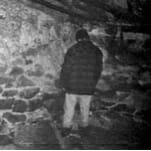The Case of the Disappearing Tall Boy
Photo via Two Roads Brewing
Call it the case of the incredible, disappearing tall boy can. I first encountered the Geyser Gose at Yes, my local organic grocery store, where you can buy overpriced nuts in bulk and a robust selection of craft beer. The Geyser came as a four-pack of tall boy cans, and my experience with Evil Twin Brewery and love for the tart/salty goodness of a gose made it a safe bet. And the beer, made by the Danish brewery along with Two Roads out of Connecticut, was incredible. Brisk, sour, a bit briny, refreshing, and totally complex—one of the best of this style that I’ve encountered since Anderson Valley’s relatively new melon-infused version.
I was back next week, looking for another four-pack, convinced I’d found the perfect gateway drug to pull more friends into the vast, complex world of sour beers. Except the beer was gone. The next week, the same fate. It felt like finding out that your favorite band was playing at your local pub, only to be forced to listen through a thick concrete wall.
Naturally I widened the search, convinced the Geyser wouldn’t become my white whale. First, I hit a beer and liquor store down the street from Yes. It’s half the size of a city block. No luck. Then, to another branch of Yes. Unlike the one that first stocked the Geyser, this store has a smaller refrigerated section, but they also carry large-format bottles of DC breweries and sorta-rare beer-makers like Maine Beer Co. Again, no luck. Not even one bottle or can from Evil Twin. So I ventured to Whole Foods, one of the better places to find left-of-center beer in Washington, DC. I knew they carried Evil Twin—I’ve pulled both their Ron and the Beast Ryan from the store’s crowded shelves, which became a go-to beer when I first discovered the funky world of brettanomyces yeast cultures. Whole Foods had ample Evil Twins in all varieties—large-format bottles, four-packs 12-ounces bottles, cans in four- and six-packs—but again, no Geyser.
How did this one beer, which seemed to register very little on the radars of my similarly-obsessed drinking friends and wasn’t featured in the beer-spotter column in the local indie weekly, suddenly disappear?
Truth told, this isn’t the first time gose pulled a disappearing act.
The style dates back the 16th century, traced to the town of Goslar, Germany. The local brewery used water that had high saline contents to deliver gose’s now-characteristic saltiness. Once fermented spontaneously, it’s now typically top-fermented with a bill grain that’s at least 50% wheat, which lends the brew its light, pale color. Spices—typically coriander—are also added to layer in some complexity and add a bit of variation to the otherwise-aggressive tang. It became a huge hit and remained popular for centuries, until breweries stopped producing it in the late 1930s because…World War II.
But it came back, first in a trickle in the mid-80s, and then in a more-steady flow.
And if DC is any indication, the style is benefiting rom a huge rise in popularity. My local pub carries cans of Anderson Valley’s The Kimmie, The Yink, & the Holy Gose, and most grocery and liquor stores worthy of a beer-lover’s affection carries either that six pack, or the Briney Melon or Blood Orange goses from the same brewery—sometimes all three. Goses are also often on tap at our growing list of beer-centric pubs, featuring both nationally distributed breweries and locals like the Old Pro from Baltimore-based Union Brewery. Hell, even craft beer powerhouse Sierra Nevada unveiled their spin on the style, using prickly pear cactus in a recipe that was years in the making.
But none of them were as memorable as the Geyser—and that includes the Mission, the other gose from Evil Twin, which I found to lack the necessary depth of flavor.
-

-

-

-

-

-

-

-

-

-

-

-

-

-

-

-

-

-

-

-

-

-

-

-

-

-

-

-

-

-

-

-

-

-

-

-

-

-

-

-








































